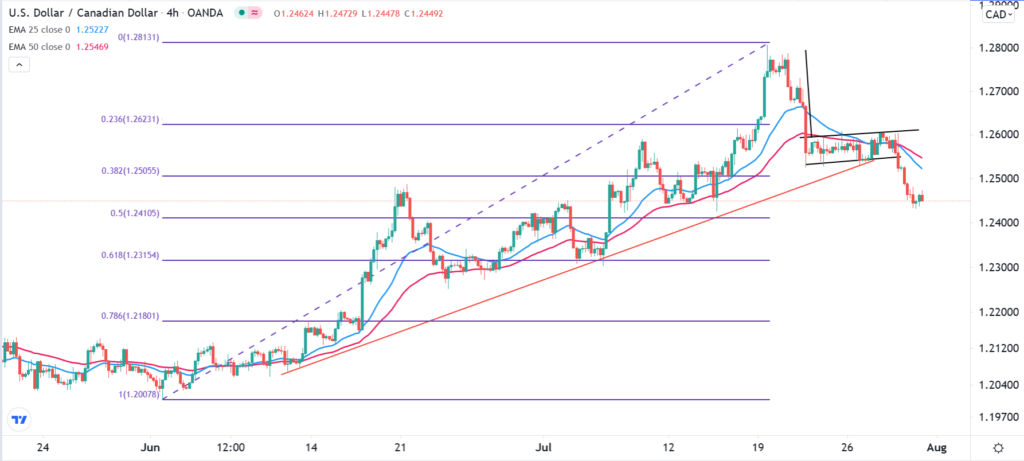The USDCAD pair declined to 1.2450 after the relatively weak US Gross Domestic Product (GDP) data. This was the lowest level since July 14, and was 2.80% below the highest point this month.
US GDP data
The American economy expanded at a relatively slower pace than expected. On Thursday, data published by the statistics bureau showed that the economy expanded by just 6.5% in the second quarter. This was a small improvement from the 6.4% growth experienced in the first quarter. It was, nonetheless, a slower pace than the median estimate of 8.5%.
Consumer spending, the biggest component of the American GDP, rose by 11.8% in Q2 after rising by 11.4% in the previous quarter. At the same time, the purchaser’s consumption expenditure (PCE), which is the Fed’s favorite inflation number, rose from 3.8% to 6.4%. This was substantially higher than the Fed’s target of 2.0%.
The main laggard for the American economy was residential investments and inventories. These sectors lagged because of the ongoing labor shortages, higher prices, and supply chain disruptions. In the past few months, companies have faced the challenge of delayed shipments and higher costs. Still, with the US battling a new Covid-19 wave, there is a possibility that the third-quarter recovery will also be relatively slower.
The USDCAD also reacted to the latest dovish Federal Reserve decision. On Wednesday, the bank left interest rates unchanged between 0% and 0.25%. The bank also pledged to continue with the asset purchases program in a bid to help the economy recover. It said that it would start deliberations on tapering in the next few meetings, possibly in November or December. The pair will next react to the latest PCE and real personal consumption data from the US.
Canada economy doing well
Meanwhile, the USDCAD has declined recently because of the ongoing divergence between the Fed and the Bank of Canada. In its most recent interest rate decision, the BOC announced that it would slash the size of its asset purchases to about C$3 billion per month. That was the third tapering since October last year.
Therefore, with the economy rebounding, there is a possibility that the bank will start hiking interest rates as soon as 2022. This will be substantially earlier than in the US, where the Fed plans to tighten in late 2023. Statistics Canada will publish the latest GDP and industrial and retail producer price index on Friday.
The Canadian dollar has also been helped by the relatively high crude oil prices. Brent has risen to $74.60, while West Texas Intermediate (WTI) has risen to $73.17. This is a substantially higher price than where oil was trading last year when the pandemic started. Oil prices are important to Canada because the country is the fourth-biggest producer in the world.
USDCAD technical forecast
The USDCAD rose to a high of 1.2809 in July. It then started a major decline and is now trading at 1.2450. Along the way, the pair formed a bearish flag pattern that is shown in black. It also moved below the ascending trendline shown in red.

Further, it has formed a head and shoulders pattern, which is below the 25-day and 50-day Exponential Moving Averages (EMA). The pair will likely continue falling as bears target the 61.8% Fibonacci retracement level at 1.2315. This prediction will be invalidated if the price moves above the 38.2% retracement at 1.2500.




